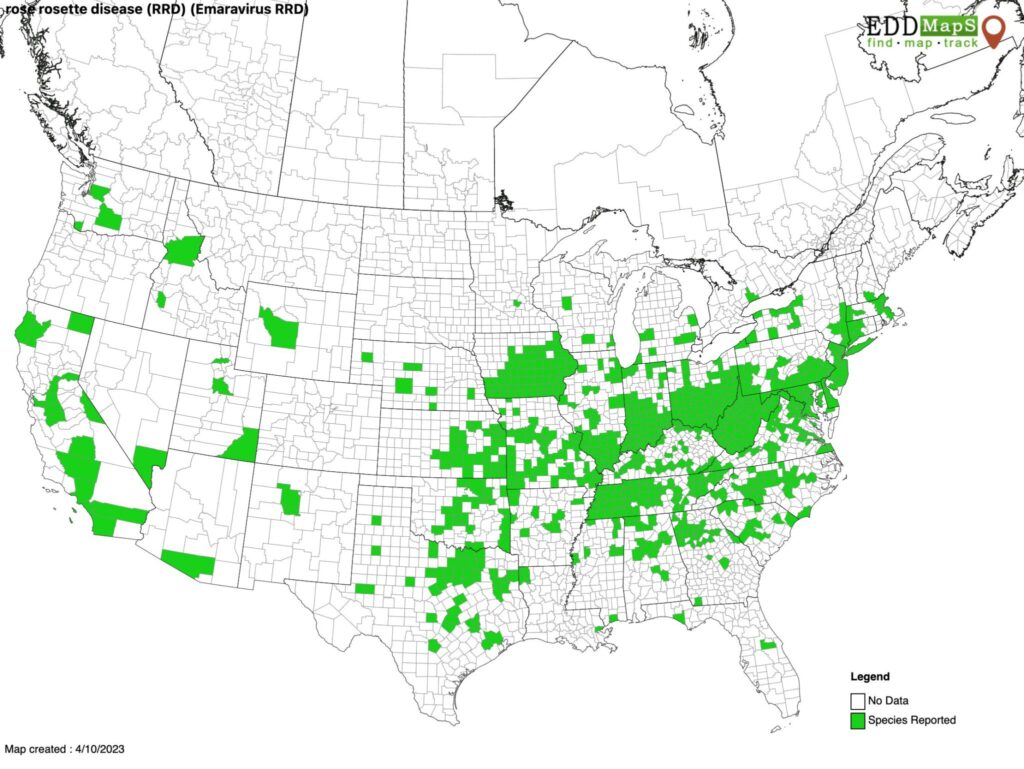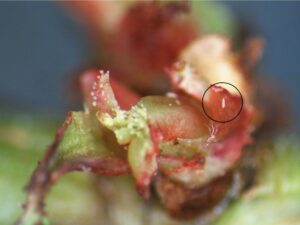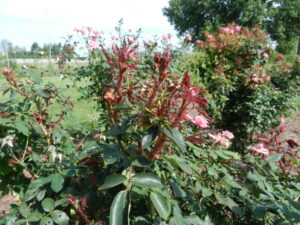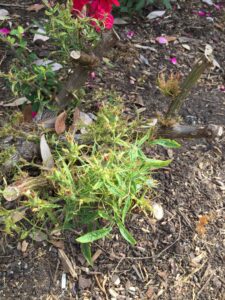Rose rosette disease is a severe problem for rose growers and occurs widely throughout many rose growing regions of the US, especially from the mid-South into the Midwest.

Figure 1: Reported distribution of Rose Rosette Disease in the US. See https://roserosette.org/distribution-map/ for the full map.

Figure 2: A single eriophyid mite (circled) is shown on a rose bud. Photo by Karen Rane.
The problem was described on roses in the early 1940s but actual cause of the disease remained murky until the pathogen was identified as a virus in 2011. You can read more about the complicated history of the search for the real cause of the disease here.
The disease is caused by Rose rosette virus (RRV) and is spread by a tiny eriophyid mite: Phyllocoptes fructiphilus (Fig 2.).
The disease has gained widespread attention in recent years when mass plantings of black spot-resistant landscaping roses (such as Knockout roses) were attacked, to devastating effect.
Symptoms
Early spring is a good time to start looking for RRV in rose plantings, since infected stems have more thorns than healthy plants (Fig 3).
Emerging shoots of rose are often somewhat red normally but those with RRV are bright red and the color persists as the stems elongate. Leaves are also stunted and twisted. The symptoms may first appear on individual stems but will eventually spread throughout the plant. For tips on early detection of RRV symptoms see this fact sheet by Univ. of Tennessee Extension. While symptoms can be an indicator of RRV the only way to be certain of the diagnosis is to do molecular testing. Check with the Purdue Plant and Pest Diagnostic Lab about testing costs.
- Figure 3: Rose shoots showing symptoms of rose rosette disease
- Figure 4. Rose with possible herbicide injury
Lookalikes
Rose rosette can also be confused with fasciation, an abnormal flattening of stems that may include bunching of flowers or leaf buds, the cause of which is not usually known. Distortion of leaves and bunchy growth can also be caused by herbicide exposure, especially exposure to glyphosate in the previous growing season. The plant shown in Figure 4 may have RRV but the lack of red color and absence of excessive thorns suggests the damage may have been caused by glyphosate exposure. In southern states Chili thrips injury has also been associated with this symptom, which is why it is important to check plants for any early symptoms prior to planting.
Management
If symptoms are detected very early and found only on a single branch it can be pruned out at the main stem, however in most cases by the time symptoms are noticed it’s too late to save the plant and the virus has moved into the main stem and root system. At that point the only option is to remove, bag and send the entire plant to the landfill, along with the root system to prevent spread to other roses in the area. Multiflora rose, an invasive weed, can harbor RRV so it should be also removed where possible.
References:
https://purdueplantdoctor.com/factsheet/tree-405
https://www.microbiologyresearch.org/content/journal/jgv/10.1099/vir.0.031146-0

